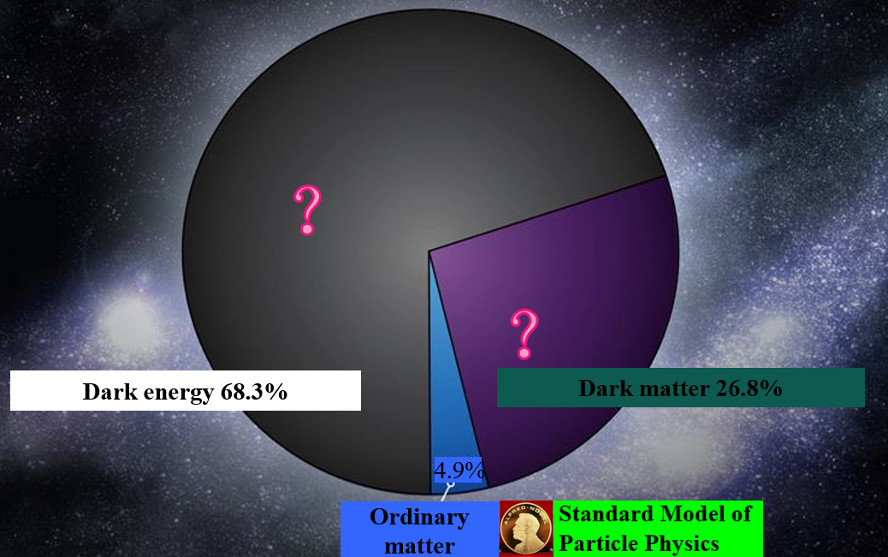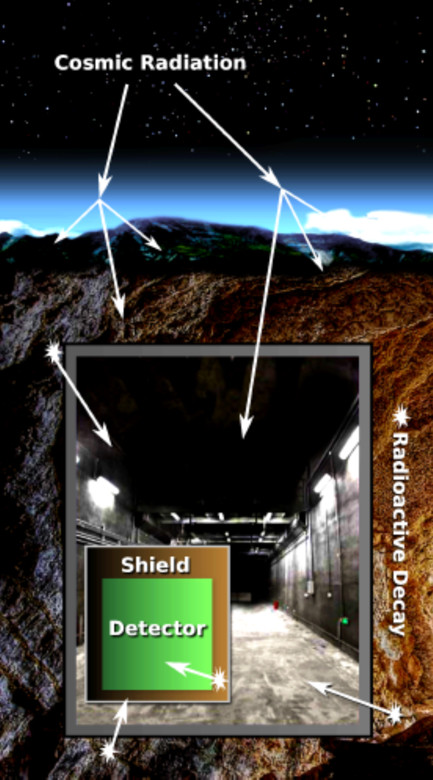物理学研究主宰自然界从“极小”到“极大”的最基本规律。微观至最基本的构成单元––即基本粒子和它们之间的相互作用,宏观至整个宇宙的形成和演化。随着上世纪宇宙”大爆炸”理论和粒子物理标准模型的诞生,科学家逐渐发现了基本粒子和宇宙之间千丝万缕的联系。但越来越多的宇宙学观测也对现有粒子理论提出了严峻挑战。比如,宇宙中看不见、摸不着的暗物质是我们已知物质的5倍多,但暗物质到底是什么?宇宙中为什么正物质远远多于反物质?中微子的非零质量的起源是什么,它们为什么这么轻?它们是不是自己的反粒子?揭开这些奥秘极有可能带来下一次物理学的革命。
We are proud being physicists exploring the secrets of nature. Particle physics studies the smallest fundamental building blocks of the nature and their interactions; and cosmology tries to understand the formation and evolution of the universe. In the last century, after the birth of the “Big Bang” theory and the standard model of particle physics, scientists were thrilled to find quantitative connections between particle physics and the evolution of universe. However, overwhelming evidences have shown that the current theory is far from complete. For example, the mass of the universe is dominated by dark matter, but aside from that it feels gravity, we do not know what is dark matter. We also do not understand why the universe nowadays contains so few anti-matters. A maybe related question is that why the neutrinos are so light, and that if they are their own anti-particles … All these mysteries could lead to the next revolution of physics.

一个新兴的交叉实验学科 - 地下物理实验,就在这些问题的驱使下诞生了。不同于传统的高能物理,这类实验不依赖于大型的加速器装置,而是往往通过低能量、极低本底干扰的粒子物理实验,探测自然界里极为稀有的事件来寻找上述问题的关键锁扣。由于地球表面的实验环境常年受宇宙射线的轰击形成严重本底干扰,而地下的实验室上方的岩石却是宇宙射线的天然屏障,从而成为这类实验的必须场所。在过去的几十年里,地下实验室里孕育出以中微子物理为代表的科学突破。美国的Raymond Davis在Homestake深地实验室里发现了来自于太阳的中微子,日本科学家小柴昌俊在神冈地下实验室发现了超新星爆发产生的中微子,从而分享了2002年的诺贝尔物理学奖。而2015年,诺奖再次垂青中微子,在神冈和加拿大斯诺地下实验室发现“中微子振荡现象”从而发现中微子有非零质量的梶田隆章和Arthur McDonald获奖。
Stimulated by these biggest unknowns, a unique type of terrestrial experiments, known as the underground physics experiments, have been developed over the last fifty years. Unlike the traditional high energy physics experiment, they do not rely on particle colliders, but rather on exquisitely low background environment to search for some rarest events in the nature. The overburdens of the underground labs protect the experiments from being bombarded by the cosmic rays. In the past several decades, we have witnessed scientific breakthroughs from the underground labs, culminated by the 2002 Nobel Prize to Raymond Davis and Masatoshi Koshiba, who discovered the solar and supernova neutrinos in the Homestake and Kamioka mines, respectively. In 2015, the Nobel prize was awarded to Takaaki Kajita and Arthur McDonald who respectively discovered the neutrino oscillation thereby showing that neutrinos have non-zero masses, from the Kamioka and SNO underground labs.

2009年,国家千人专家季向东教授在上海交通大学物理成立了地下物理研究团队,从国外一流大学里引进了一批青年学者,正在上述的多个前沿领域开展实验研究,已经取得了多个有国际影响力的成果。在国际埋深最深的中国四川的锦屏地下实验室里,上海交大团队牵头的PandaX的实验正利用液氙开展对暗物质粒子的寻找,PandaX二期500公斤级实验在2016年取得了国际上灵敏度最高的暗物质直接探测结果。在中微子领域,交大团队重点参与的大亚湾中微子实验于2012年发现了中微子第三种振荡模式,成果获得2015年国际基础科学“突破奖”;也大力投入江门地下中微子实验(JUNO)中测量中微子的质量顺序。为了验证中微子是否是它的反粒子(所谓的Majorona费米子),交大团队将开展两个实验开展对极其稀有的“无中微子双贝塔衰变”的寻找:第一个实验是PandaX-III, 将在锦屏实验室用高压气体径迹探测器测量${}^{136}Xe$的衰变;另一个实验叫CUORE,在意大利的Gran Sasso地下实验室里用极低温量能器对${}^{130}Te$的衰变进行测量。
The underground physics group at SJTU was established in 2009, by the National 1000-Talent Chair Professor Xiangdong Ji, who recruited number of excellent junior researchers from top-notch oversea institutes. In these years, team at SJTU has been carrying out cutting edge research in several different directions, and has produced important results. In the world deepest underground lab, the China JinPing underground Lab, we lead the PandaX project to search for dark matter particles using the so-called dual-phase xenon detector. The second phase of this project, PandaX-II, has become the world largest and the most sensitive running experiment. In neutrino physics, we participated in the Daya Bay neutrino experiment, which unambiguously discovered the third type of neutrino oscillation in 2012; and as a sequel, we are now participating in the Jiangmen Underground Neutrino Observatory (JUNO) experiment, aiming to determine the mass ordering of the three type of neutrinos. In order to determine if neutrinos are their anti-particles (known as the Majorana fermions), we are carrying out searches for the neutrinoless double beta decay, one of the rarest decay in the nature, with two different experimental techniques. One experiment is the PandaX-III in JinPing, which uses the high pressure xenon tracking detector to search for such decay in ${}^{136}Xe$. The other experiment called CUORE is in the Gran Sasso Laboratory in Italy, which uses extremely low temperature (6 mK) bolometer to search for such decay in ${}^{130}Te$.
当然,Ray Davis仅仅是想测太阳中微子,却意外的发现了太阳中微子流量的“消失”––也就是后来的中微子振荡;小柴昌俊仅仅是想测量质子衰变,却意外的因为发现了超新星中微子而名留青史。我们利用这些极高灵敏度、极低本底实验去验证、挑战人类的想象,甚至发现全新的现象而触发革命性的突破,的那岂不是更加激动人心?! 你想加入我们的行列么?
On the other hand, Davis was only keen on measuring the neutrinos from the sun, but he accidentally stumbled into the missing of solar neutrino flux, which was later explained by the neutrino oscillation. Koshiba only wanted to build a detector to measure the decay of protons, but also out of coincidence the neutrinos from the supernova explosion in 1987 made him famous. One could well hope that in pursuing these extremely clean and sensitive experiments to challenge the imagination of the human beings, we may bump into something completely new. Is this not even more exciting?! Come and join us!!!
